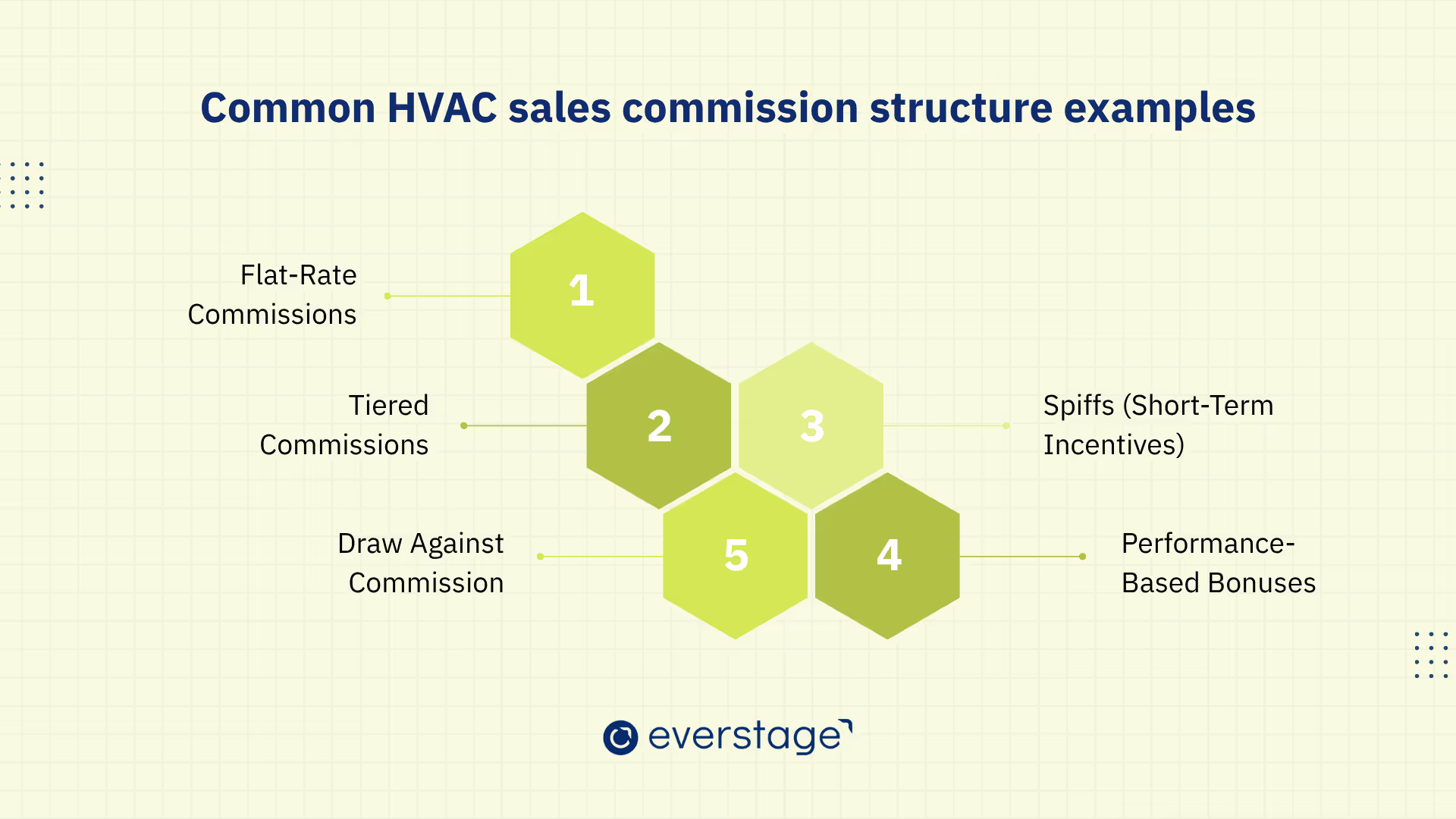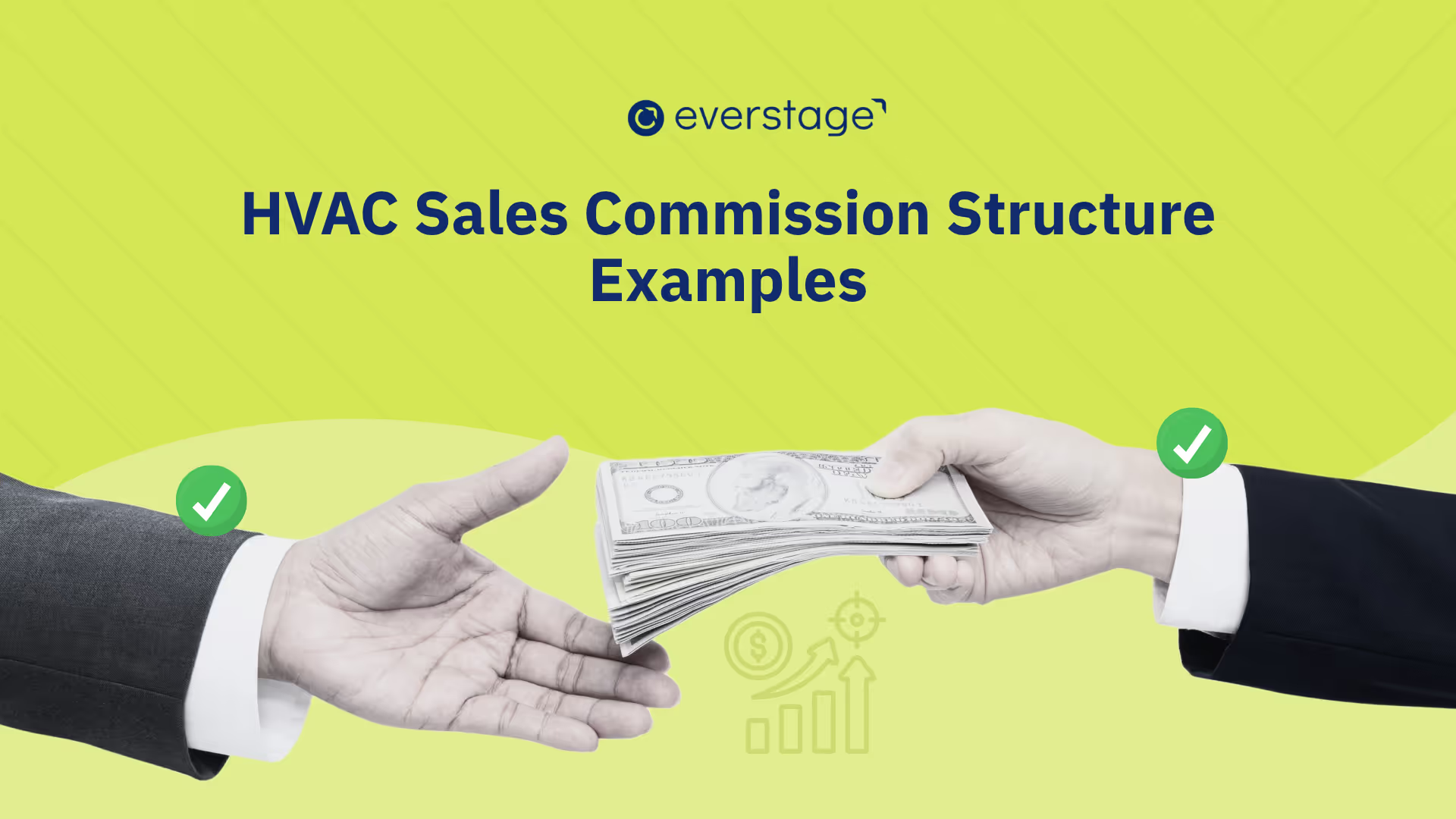Sales reps are closing deals. Systems are getting installed. But at the end of the month, the numbers don’t add up. Revenue looks strong, but profit margins tell a different story, and somehow, the commission payouts feel disconnected from the actual health of the business.
If you’ve ever looked at your sales reports and wondered why your top-performing rep is also selling the most discounted jobs, the problem might not be the salesperson —or even the sales manager. It might be the commission plan.
In the HVAC industry, the way you structure commissions doesn’t just determine how much a rep earns; it shapes the decisions they make every day. From pricing conversations to upsells and follow-through, the incentive model quietly drives behavior. And when it’s misaligned with your goals, it can hurt more than it helps.
This guide breaks down what HVAC sales commission structures really look like in the field today. You’ll learn how different structures work, where they go wrong, and how to build one that motivates your team without sacrificing margin or control.
What Is an HVAC Sales Commission Structure?
A sales commission structure in HVAC defines how sales reps are paid for the deals they close, most commonly as a percentage of revenue or gross profit. It’s more than just a payout formula. It’s a framework that links individual performance to business outcomes through structured commission payments.
In most HVAC companies, commissions are paid out when a rep closes a job—whether that’s a full system replacement, an upsell on ductwork, or an annual maintenance agreement. But how that commission is calculated can vary widely.
Well-structured commission plans reward the right behaviors. They push reps to close quality jobs, maintain price integrity, and stay focused during both peak seasons and the slower months. Poorly designed ones, on the other hand, often lead to discounting, cherry-picking, and internal tension over unclear payouts.
Why A Good HVAC Sales Commission Structure Matters
A commission plan shapes behavior, protects margins, and creates a healthy rhythm for your business. The way you compensate your team has a ripple effect on what they prioritize, how they close deals, and ultimately, how profitable your operation becomes.
It Motivates Sales Reps the Right Way
When reps have clarity on what they’ll earn and how to get there, they bring more energy to the table. A commission structure that rewards effort and consistency gives them a clear path to success, without constantly needing reminders or micromanagement.
The best-performing teams aren’t always the ones with the highest base salaries. They’re the ones where commissions are fair, transparent, and tied to behaviors that grow the business.
It Encourages Value-Based Selling
Revenue-only commissions can backfire. Reps may feel pressured to discount heavily just to close a job, especially when competing against lower-priced contractors. That might bring in volume, but not necessarily value.
When commissions are linked to profitability, full-price sales, or high-efficiency products, reps shift focus. They sell with confidence, justify the value, and protect the company’s margins without being told to.
It Protects Margins and Revenue Predictability
Every time a rep drops the price to win a job, your margin shrinks—and in a flat-rate commission model, their payout often stays the same. That creates a disconnect between what benefits the rep and what benefits the business.
Structures that account for profit, or offer tiered rewards for higher-value jobs, help avoid that problem. They also make it easier to forecast revenue and expenses because you're not constantly offsetting thin-margin work with volume.
Common HVAC Sales Commission Structure Examples

There’s no one-size-fits-all when it comes to HVAC sales commissions. What works for a residential-focused team might fall short in a commercial setting. That’s why it’s helpful to look at real-world structures used across the industry—each with its pros, pitfalls, and use cases.
Flat-Rate Commissions
This is the most straightforward model. Reps earn a fixed percentage of the total sale, regardless of what’s sold, how it’s priced, or how profitable the job is.
For example, if a rep closes a $15,000 system replacement and the company offers a 6% straight commission, the payout would be $900. Simple math. No gray areas.
Flat-rate structures are easy to explain and easy to calculate. But they also come with a risk. Because the payout is tied only to the sale amount, reps may feel encouraged to discount just to close the deal quickly, without considering how much margin is left on the table.
This kind of model is often used for experienced salespeople working on high-ticket installs, where volume is steady and margin control is less of a concern.
Tiered Commissions
Tiered models raise the commission rate as reps sell more, creating natural incentives to push higher volume. For example, a rep might earn:
- 3% on the first $10,000
- 5% on the next $10,000
- 7% on anything above $20,000
If they sell $25,000 in a month, they’d earn $1,150 in total commission.
This structure rewards reps who go beyond their quota and encourages upselling. It’s also flexible; businesses can adjust tiers to match seasonal trends or growth goals. But there’s a catch: if not tracked closely, reps may “sandbag”—in HVAC terms, delay installations to time commission payouts with seasonal peaks.
Spiffs (Short-Term Incentives)
Spiffs are bonuses paid for specific actions, like selling a maintenance plan, a high-efficiency upgrade, or a ductwork add-on. These are typically one-time payments that stack on top of base pay commissions.
For instance, a rep might earn an extra $100 for each maintenance agreement sold or $500 for closing a top-tier AC unit. It’s a quick way to drive focus on a certain product or behavior.
Spiffs are great for short bursts of energy, like during slow seasons or product pushes. But if not carefully monitored, they can eat into profitability and create tension between sales and service teams.
Performance-Based Bonuses
These go beyond deal-by-deal commissions. Bonuses are tied to overall metrics like total revenue, number of jobs closed, customer satisfaction scores, or review counts.
In HVAC terms, a rep might receive a $1,000 bonus for maintaining installation quality scores above 95% over a quarter, or a $300 bonus for keeping callback rates and warranty claims below a certain threshold (e.g., fewer than 3 callbacks per month). This model incentivizes consistency, high-quality installations, and excellent customer service, not just sales volume.
It’s especially useful for HVAC companies aiming to differentiate themselves through superior workmanship and lasting customer relationships. However, to make it work, these criteria must be clearly communicated and consistently tracked. When KPIs are vague or frequently changing, technicians may become disengaged and lose motivation.
Draw Against Commission
This is a hybrid model that provides reps a guaranteed base income, known as a "draw," paid as an advance against future commissions. If their earned commissions exceed the draw, they keep the difference. If not, the draw may roll forward or reduce future payouts.
In HVAC, draws are especially useful during slow seasons, like winter months, when installation and repair requests typically decline. For example, let’s say an HVAC sales rep receives a monthly draw of $3,000. During a slow winter month, they may only earn $2,000 in actual commissions. They still receive the full $3,000, but the $1,000 shortfall is carried forward. When spring arrives and demand increases, if they earn $5,000 in commissions, they'll receive $4,000—their earned commission minus the prior month's $1,000 shortfall.
This model provides income stability for HVAC reps during seasonal dips, keeping them engaged and motivated. However, it requires precise tracking and clear communication, especially if reps frequently fall short of their draws.
How to Choose the Right Commission Structure

Designing the right commission structure isn’t just about choosing between flat-rate or tiered models. It’s about understanding your sales process, your business goals, and the behavior you want to encourage. The best compensation plan is the one that motivates your team and keeps your margins intact.
Align Sales Behavior with Company Goals
If the goal is to increase top-line revenue, a flat-rate or tiered structure might work well. But if protecting profitability is a priority, tying commissions to gross profit can change how reps approach pricing and upselling. Instead of cutting prices to win deals, they’ll focus on selling full-value solutions.
For example, many HVAC companies implement minimum margin thresholds, typically in the 40–60% gross margin range, ensuring commissions only trigger if a job meets these profitability benchmarks. This approach discourages heavy discounting and encourages reps to prioritize high-efficiency equipment, bundled services, and comprehensive maintenance plans, solutions that enhance long-term customer value and company profitability.
Minimize Profit Leakage from Discounts
One of the most common issues with traditional commission models is the incentive to win deals at any cost. When reps are paid based solely on revenue, a deep discount can look just as good as a premium sale, at least on paper.
Profit-sharing structures or margin-based bonuses help solve this problem. Some companies implement a sliding scale: the higher the margin, the higher the payout. Others penalize reps for dropping below a set price floor. It’s about creating friction where it’s needed so that price cutting isn’t the easy way out.
Balance Simplicity and Incentive Power
There’s a fine line between motivating reps and overwhelming them with math. A plan that’s too complex or full of hidden conditions can confuse even your best performers. At the same time, a plan that’s too simple may miss important levers like profit, seasonality, or service add-ons.
The key is clarity. Whatever model you choose, reps should understand how they’re paid and what they need to do to maximize their earnings. Commission software can make this easier by giving reps a real-time view of their numbers and helping owners model different payout scenarios before rolling them out.
Choosing the right structure is less about copying someone else’s system and more about designing a model that fits your sales team, your customer base, and the kind of business you’re trying to grow.
Challenges in HVAC Commission Systems and How to Solve Them
Even the best-designed commission plans can run into problems once they’re in the field. From miscommunication to inconsistent tracking, these issues can erode trust and performance if left unchecked. But most of them are fixable—with the right systems and a bit of foresight.
- Lack of Transparency in Payouts
When sales reps don’t clearly understand how their commissions are calculated, motivation takes a hit. This is especially true in hybrid plans that combine flat rates, spiffs, and performance bonuses.
The solution is simple: transparency. Use payout sheets that show the job-level breakdown, or invest in commission tracking software like Everstage. These tools give reps real-time visibility into how each deal contributes to their commission total—no spreadsheets, no confusion.
- Misaligned Incentives
If your plan rewards revenue but ignores margin, it’s only a matter of time before reps start prioritizing big deals over profitable ones. That might look good on paper, but when installation costs rise or pricing gets aggressive, you’re left wondering why your gross profit isn’t matching up.
This is where gross profit-based commissions or margin-protected tiers can make a huge difference. Some companies tie payouts to a minimum gross margin threshold (say, 35%), so reps are rewarded for protecting value, not just chasing volume.
- Manual Errors in Commission Calculation
Most HVAC businesses start with spreadsheets, and for a while, that works. But as the team grows and commission structures get layered with spiffs, bonuses, and variable margins, errors creep in. One mistake in a formula or a missed line item can spark disputes that take hours to resolve. Worse, repeated errors can damage rep trust and lead to missed payouts.
Automating your commission process eliminates that risk. Tools like Everstage (used across sales-driven industries) are designed to handle tiered plans, bonuses, and profit splits with clean audit trails and payout approvals built in.
- Seasonal Revenue Swings
HVAC is a seasonal business. Summer might bring a flood of sales, but winter? Not so much. That can leave even your top performers with inconsistent pay and lower morale during slower months.
One way to smooth this out is by offering a draw against commission. This provides reps with a consistent monthly income that’s “reconciled” when commissions are paid out. Alternatively, some companies use rolling KPIs or season-adjusted targets to keep goals realistic throughout the year.
- Over-Reliance on Discounts to Close Deals
In flat-rate models, a discounted job earns the same commission as a full-price one. That’s a problem. Over time, reps may learn that dropping prices is the fastest way to hit their numbers, and once that habit forms, it’s hard to reverse.
To counter this, more businesses are introducing profit-based commissions or tiered payouts tied to sale price integrity. If a rep closes at full price, they get more. If they discount, their commission rate drops.
Conclusion
A well-designed HVAC sales commission structure is more than just a way to pay your team, it’s a strategy to align behavior and protect your margins. The challenge isn’t picking the flashiest plan. It’s building one that fits your goals, your sales cycle, and the reality of your day-to-day operations.
Flat-rate models may work for quick, high-volume sales. Tiered structures can push reps to go the extra mile. Spiffs and performance bonuses are great for short bursts of motivation. And profit-based models help keep everyone focused on selling value, not just volume. Each structure has its place, but none of them work without clarity, consistency, and alignment.
The best place to start is with real numbers. Look at your margins, your most common job types, and how reps are currently closing deals. Run the numbers on different models and test how payouts would shift if you moved from revenue-based to profit-based commissions. Most importantly, talk to your team. If they don’t understand how they’re paid or don’t trust the system, it won’t matter how smart the math is.
If you’re looking to simplify the process and reduce the headaches of spreadsheets and manual tracking, tools like Everstage can help. You can customize commission rules, visualize team performance in real-time, and eliminate payout errors.
Book a free demo today and see how Everstage can help you build a commission system that works for your team and your business.
Frequently Asked Questions
What’s the average HVAC sales commission percentage?
Typical HVAC sales commissions vary by job type:
- Maintenance: 2–3%
- Repairs: 5–8%
- Replacements: 8–12%
Commercial projects may offer 30–50% of gross profit, depending on complexity.
Should commissions be based on revenue or profit?
It depends on what you value more—simplicity or margin protection. Revenue-based commissions are easier to calculate and explain, but they often encourage price-cutting. Profit-based commissions, while more complex, better align rep behavior with your financial goals. Many businesses start with revenue-based models and gradually introduce profit-based tiers once they have clear job costing in place.
Can HVAC techs also earn commissions?
Yes, and many do. Technicians often receive spiffs or small commissions for identifying upsell opportunities, closing maintenance agreements, or recommending system upgrades. This not only drives more revenue but also builds stronger collaboration between sales and service teams.
How do I switch from a revenue-based to a profit-based plan?
Start by running both models side by side. Use your last 3–6 months of sales data to compare how rep payouts would look under each system. This helps set expectations and gives your team a clear understanding of the shift. Training is essential, especially around job costing and margin tracking. Tools like ServiceTitan or Everstage can help you model the change and communicate it clearly.
Are commission plans different for commercial vs. residential HVAC?
They often are. Commercial HVAC sales involve longer deal cycles, custom pricing, and more stakeholders, so profit-based or hybrid commission structures are more common. In residential, flat-rate or tiered percentage models tend to work well because sales cycles are shorter and pricing is more standardized.




.avif)
.avif)






